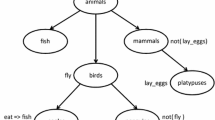Abstract
Problem statement: behavior of SEMS-based robots is modeled by a knowledge base (KB) represented in different formats (semantic networks, sets of productions, etc.), and the robots interactions model can be represented as an integrated KB. During development and operation KBs, there exists a problem of their anomalies. Retarded detection of such anomalies can lead to malfunctions and breakdowns. Anomalies of inconsistency play an especially important role in faults diagnostics for robots teams. A large number of publications have been devoted to the methods of detecting these and other anomalies. At the same time, methods to eliminate anomalies lack for adequate studies. Purpose of research: development of new methods for detecting anomalies of inconsistency, as well as algebraic methods for eliminating some anomalies in integrated KBs of interacting robots, in particular, the contradiction anomaly during logical inference. Results: an overview of techniques to detect anomalies in integrated KBs of interacting robots is presented. Presupposition is shown to be one of examples of the contradiction anomaly during logical inference. Presupposition is often encountered in texts and has a property of existence of mutually exclusive conclusions from the same premise. A method for explaining and eliminating this anomaly is proposed. Practical significance: the proposed techniques of anomalies detection and elimination can be used to control robots teams in order to decrease failures in their functioning.
Access this chapter
Tax calculation will be finalised at checkout
Purchases are for personal use only
Similar content being viewed by others
References
Gorodetskiy, A.E. (ed.): Smart Electromechanical Systems. Springer International Publishing (2016)
Bond, A., Gasser, L.: Readings in Distributed Artificial Intelligence. Morgan Kaufmann, San Mateo, CA (1988)
Luce, R.D., Raiffa, H.: Games and Decisions. Wiley, New York (1957)
Myerson, R.: Game Theory: Analysis of Conflict. Harward University Press, Cambrige, Massachusetts (1991)
Varshavsky, V.I.: Collective Behavior of Automata. Nauka, Moscow (1973). (in Russian)
Wooldridge, M.: An Introduction to Multi-agent Systems. Wiley (2009)
Gorodetsky, V.I., Skobelev, P.O.: Industrial applications of multi-agent technology: reality and perspectives. SPIIRAS Proc. 6(55) (2017) (in Russian)
Kulik, B.A., Zuenko, A.A., Friedman, A.Ya.: Deductive and defeasible reasoning on the basis of a unified algebraic approach. Sci. Tech. Inf. Process. 42(6), 402–410 (2015)
Kulik, B.A., Fridman, A.Ya.: Logical analysis of data and knowledge with uncertainties in SEMS. In: Gorodetskiy, A.E. (eds.) Studies in Systems, Decision and Control. Smart Electromechanical Systems, vol. 49, pp. 45–59. Springer International Publishing Switzerland (2016)
Kulik, B.A., Fridman, A.Ya.: Unified logical analysis in robots’ CNS based on N-Tuple algebra. In: A.E. Gorodetskiy, V.G. Kurbanov (eds.) Smart Electromechanical Systems: The Central Nervous System. Series: Studies in Systems, Decision and Control, vol. 95, Chapter 2, pp. 17–30. 1st edn. Springer (2017)
Ruttkay, Z.: Constraint satisfaction—a survey. CWI Q. 11, 163–214 (1998)
Zuenko, A.A.: Constraint inference upon matrix representations of finite predicates. Artif. Intell. Decis. Making 3, 21–31 (2014). (in Russian)
Preece, A.D.: Validation of knowledge-based systems: the state-of-the-art in North America. J. Comm. Cogn. Artif. Intell., 1(№ 4) (1994)
Felfernig, A., Friedrich, G., Jannach, D., Stumptner, M.: Consistency-based diagnosis of configuration knowledge bases. AI J. 152(2) (2004)
Baumeister, J., Seipel, D.: Anomalies in ontologies with rules. Web Semant. Sci. Serv. Agents World Wide Web 8(1) (2010)
Nguyen, T.A., Perkins, W.A., Laffey, T.J., Pecora, D.: Knowledge base verification. AI Mag. 8(№ 2) (1987)
Strawson, P.: Introduction to Logical Theory. London (1952)
van Fraassen, B.: Presupposition, implication and self-reference. J. Philos. 65(№ 5) (1968)
Beaver, D.: Presupposition and Assertion in Dynamic Semantics. Ph.D. Dissertation, University of Edinburgh (1995)
Karttunen, L., Peters, S.: Requiem for presupposition [microform]. Lauri Karttunen and Stanley Peters, Distributed by ERIC Clearinghouse (1977)
Lakoff, G.: Women, Fire, and Dangerous Things. The University of Chicago Press, Chicago, IL (1987)
Bandler, R., Grinder, J.: The Structure of Magic I: A Book About Language and Therapy. Science & Behavior Books, Palo Alto, CA (1975)
Popov, E.V.: Communication with a Computer in a Natural Language. Nauka, Moscow (1982). (in Russian)
Pospelov, D.A.: Modeling of Reasoning. Experience in Analysis of Mental Acts. Radio i Svyaz’, Moscow (1989). (in Russian)
Russel, S., Norvig, P.: Artificial Intelligence: A Modern Approach, 2nd edn. Prentice Hall (2003)
Thayse, A., Gribomont, P., Hulin, G., et al.: Approche logique de l’intelligence artificielle, vol. 1. De la logique classique a la programmation logique, Paris (1988)
Frege, G.: Sinn und Bedeutung. In: Frege G. Funktion, Begriff, Bedeutung. Fünf logische Studien, pp. 38–63. Vandenhoeck & Ruprecht, Göttingen (1962)
Acknowledgements
The authors would like to thank the Russian Foundation for Basic Researches (grants 16-29-04424, 16-29-12901, 18-07-00132, 18-01-00076) for partial funding of this research.
Author information
Authors and Affiliations
Corresponding author
Editor information
Editors and Affiliations
Rights and permissions
Copyright information
© 2019 Springer Nature Switzerland AG
About this chapter
Cite this chapter
Kulik, B.A., Fridman, A.Y. (2019). Techniques to Detect and Eliminate Inconsistencies in Knowledge Bases of Interacting Robots. In: Gorodetskiy, A., Tarasova, I. (eds) Smart Electromechanical Systems. Studies in Systems, Decision and Control, vol 174. Springer, Cham. https://doi.org/10.1007/978-3-319-99759-9_14
Download citation
DOI: https://doi.org/10.1007/978-3-319-99759-9_14
Published:
Publisher Name: Springer, Cham
Print ISBN: 978-3-319-99758-2
Online ISBN: 978-3-319-99759-9
eBook Packages: Intelligent Technologies and RoboticsIntelligent Technologies and Robotics (R0)




